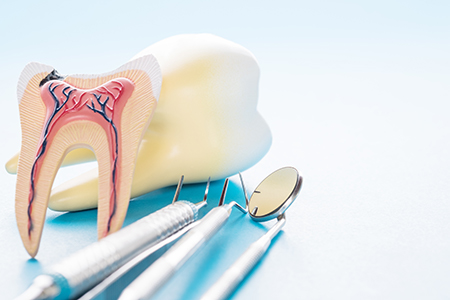Existing Patients
(740) 393-2161
New Patients
(740) 200-4777

Being told you need a root canal can feel unsettling, but the procedure is a predictable, well-established way to stop tooth pain and preserve the natural tooth. With modern instruments and anesthesia, most root canal treatments are no more uncomfortable than having a dental filling and are far less invasive than extraction and replacement.
At Brian Howe DDS, Family Dentistry, our focus is on relieving discomfort, protecting oral health, and keeping your smile intact whenever possible. We combine conservative decision-making with up-to-date techniques to ensure your treatment is effective and comfortable.
When the soft tissues inside a tooth — the pulp — become infected or irreversibly damaged, the structural integrity of that tooth and the comfort of the patient are at risk. Root canal therapy removes diseased tissue, disinfects the internal space, and seals the canals to prevent reinfection. This approach preserves the tooth's natural function and appearance while avoiding the additional challenges that come with replacing a lost tooth.
Keeping your natural tooth supports chewing efficiency, helps maintain jawbone health, and prevents neighboring teeth from shifting. In many cases, saving the tooth with endodontic therapy is the most conservative, long-term solution for both oral health and daily comfort.
Root canal treatment is refined work that relies on careful diagnosis and meticulous technique. Our team emphasizes conservative restoration after therapy so the repaired tooth can withstand the forces of biting and continue to perform well for years when cared for properly.

Teeth are more than enamel and dentin; they contain a central chamber with nerves and blood vessels that respond to injury and infection. When that inner tissue becomes inflamed or dies, it can trigger a range of symptoms that warn you something is wrong. Paying attention to these signals helps catch problems before they escalate.
Sometimes the earliest sign is sensitivity that won’t go away — a sharp reaction to hot or cold, or pain when biting and chewing. Other times a tooth can darken, or surrounding gum tissues may swell as the body pushes back against infection. Because the presentation varies, a thorough clinical exam and radiographs are often needed to understand the full picture.
Not every ache requires endodontic treatment, but when multiple warning signs line up — persistent pain, swelling, or radiographic changes — prompt evaluation and treatment improve the likelihood of saving the tooth and preventing further complications.
Below are common warning signs that a tooth may require root canal therapy:
Steady, intense pain that lingers or wakes you at night often indicates nerve irritation or infection. Unlike brief sensitivity, persistent pain is a strong clue that the inner tissues of the tooth are compromised and should be examined without delay.
Occasional sensitivity is common, but severe or prolonged reactions to hot and cold can signal inflammation of the pulp. If sensitivity continues after the stimulus is removed, it suggests deeper involvement beyond the outer tooth layers.
Discomfort when chewing or when the tooth is tapped may mean the nerve or supporting tissues are inflamed. This symptom can be particularly telling if it persists across multiple days or grows worse with use.
A tooth that shifts color — grayish, brown, or darker than its neighbors — can indicate internal changes following trauma or prolonged infection. Discoloration alone does not confirm the need for a root canal, but it is a signal to investigate further.
Mechanical injury that exposes or compresses internal tissues can allow bacteria to reach the pulp. Even small fractures can lead to significant internal problems over time, making evaluation important after any injury.
Localized swelling, a tender lump near the tooth root, or drainage are signs of infection that has escaped the tooth and reached the surrounding tissues. These findings warrant prompt treatment to control the infection and address its source.
Advanced infection can damage the bone and ligaments that support a tooth, causing mobility. Root canal therapy combined with appropriate restorative care often stabilizes the tooth as the tissues heal.

Quick evaluation and treatment limit the spread of infection and reduce the chance of complications. In many cases, an affected tooth is first detected during a routine exam or on a radiograph before severe symptoms develop. When identified early, the treatment tends to be more straightforward and healing is generally faster.
Delaying care can allow bacteria to invade deeper structures or spread to adjacent teeth and bone, potentially requiring more complex solutions. Timely endodontic treatment preserves the tooth and helps prevent the need for future, more invasive procedures.
Our approach is to diagnose carefully using clinical findings and imaging so we can recommend the most conservative and predictable path forward. Acting promptly when a problem is suspected gives you the best chance of keeping your natural tooth healthy and functional.
Contemporary root canal therapy follows a clear sequence designed to remove infection, shape the internal anatomy, and protect the tooth. After numbing the area with local anesthesia, the tooth is isolated and the dentist gains access to the pulp chamber. Specialized instruments are then used to clean and shape each canal to remove diseased tissue.
Irrigation with disinfecting solutions and careful drying are critical steps before the canals are filled with a biocompatible material that seals the internal space. Depending on the tooth's complexity and the presence of infection, this work can sometimes be completed in a single visit, or it may be staged across two appointments for optimal results.
For patients who feel anxious, dental sedation options can be offered to promote relaxation during treatment. After the internal work is complete, the tooth is sealed with a temporary or permanent filling, and planning begins for an appropriate definitive restoration, often a crown, to restore strength and function.

Immediately after treatment you may experience temporary numbness until the local anesthetic wears off. Mild soreness and sensitivity around the treated tooth are common for a few days and can usually be managed with over-the-counter pain relievers as recommended. If antibiotics are prescribed, it’s important to complete the full course as directed.
While a root canal removes infection from inside the tooth, it leaves the remaining natural structure more vulnerable until a permanent restoration is placed. Patients should avoid biting hard foods on the treated tooth and follow instructions to protect it until the final crown or definitive restoration is in place.
Good oral hygiene and regular dental visits help ensure the long-term success of root canal therapy. With proper restoration and care, a treated tooth can function for many years — often for a lifetime. If unusual symptoms such as increasing pain, swelling, or drainage occur after treatment, prompt re-evaluation is important.
At Brian Howe DDS, Family Dentistry, we prioritize gentle, evidence-based care throughout diagnosis, treatment, and follow-up to support durable outcomes and patient comfort.
In summary: root canal therapy is a reliable way to stop pain, remove infection, and preserve your natural tooth. If you have persistent tooth pain, swelling, or any of the warning signs described above, please contact us to learn more or to schedule an evaluation. We are happy to discuss your options and help you make the best choice for your oral health.
A root canal is a dental procedure used to remove infected or damaged pulp from inside a tooth and to seal the internal space to prevent reinfection. The goal is to preserve the natural tooth structure and restore its function rather than extracting the tooth. Modern root canal therapy focuses on thorough cleaning, disinfection, and a durable seal to support long-term health.
This treatment is performed using local anesthesia and specialized instruments to access the pulp chamber and canals. When completed and followed by an appropriate restoration, a tooth treated with endodontic therapy can continue to function as part of the bite. The procedure is considered a conservative, tooth-preserving option compared with extraction and replacement alternatives.
A root canal is typically recommended when the pulp inside a tooth becomes inflamed, infected, or irreversibly damaged due to deep decay, trauma, repeated dental work, or a crack in the tooth. Symptoms that often prompt evaluation include persistent pain, heightened sensitivity to heat or cold, pain when biting, swelling, or darkening of the tooth. Clinical examination and radiographs help determine whether the pulp can be saved or if extraction is necessary.
Not all toothaches require root canal therapy, so careful diagnosis is essential to identify the precise problem and the most conservative treatment path. Early detection often leads to simpler treatment and a higher chance of preserving the natural tooth. If infection has spread beyond the tooth, prompt intervention reduces the risk of further complications.
The procedure begins with isolating the tooth and administering local anesthesia to ensure comfort throughout treatment. The dentist creates an access opening to reach the pulp chamber and uses small instruments and irrigation solutions to remove diseased tissue, clean the canals, and shape them for filling. After thorough disinfection, the canals are sealed with a biocompatible filling material to prevent bacteria from re-entering the restored space.
Depending on the tooth's complexity and the presence of infection, the dentist may complete the work in a single visit or stage it across two appointments to optimize healing. Once the internal work is complete, the tooth is sealed with a temporary or permanent filling and planning begins for a definitive restoration, often a crown, to restore strength and function. Good communication about each step helps patients know what to expect and how to care for the tooth afterward.
Thanks to modern anesthesia and techniques, most patients experience little to no pain during a root canal procedure, and many compare the sensation to having a filling placed. Local anesthesia numbs the area, and the clinician takes steps to work efficiently and reduce discomfort. For patients who feel anxious, sedation options are available to promote relaxation during the procedure.
Mild soreness and tenderness around the treated tooth are common for a few days after the appointment as surrounding tissues recover. These symptoms can usually be managed with over-the-counter pain relievers as recommended and tend to improve steadily within a short period. If pain increases or new symptoms develop after treatment, patients should contact the office for reevaluation.
Immediately after treatment you may have numbness from the local anesthetic and mild soreness as the anesthetic wears off. It is common to experience some sensitivity or tenderness around the tooth for several days, particularly when chewing or biting, and symptoms generally subside with conservative self-care and short-term analgesics. If antibiotics are prescribed for a spreading infection, it is important to complete the full course as directed by the clinician.
Until a permanent restoration is placed, the treated tooth can be more susceptible to fracture, so patients should avoid chewing hard foods on that side and follow any protective instructions provided. Regular follow-up visits allow the dentist to confirm healing and proceed with a definitive restoration, which helps secure the long-term success of the treatment. Persistent or worsening symptoms should prompt a prompt return visit for reassessment.
Yes, root canal therapy is often the recommended treatment to save teeth that have suffered trauma or extensive decay that reaches the pulp. By removing infected or necrotic tissue and sealing the internal anatomy, the procedure resolves pain and prevents the spread of infection while preserving the natural root and tooth structure. Saving the tooth maintains chewing efficiency and helps prevent neighboring teeth from shifting.
The prognosis depends on the extent of damage, the presence of infection, and the quality of subsequent restoration to protect the remaining tooth. Prompt evaluation after injury or when deep decay is detected improves the likelihood of a successful outcome. In some complex cases additional endodontic procedures or referral to a specialist may be advised to achieve the best long-term result.
With proper restoration and ongoing oral hygiene, a tooth treated with root canal therapy can last many years and often for the remainder of a patient’s life. The long-term success of the treatment depends on thorough cleaning and sealing of the canals, appropriate restorative protection such as a crown when indicated, and regular dental checkups to monitor the tooth. Avoiding habits that stress the tooth, like chewing hard objects, also supports longevity.
Occasionally a tooth may need retreatment if recurrent infection or new issues arise, and such cases can frequently be managed successfully with additional endodontic care. Regular radiographic follow-up helps detect problems early so they can be addressed before causing significant damage. Patients who maintain good oral health habits and attend preventive visits give their treated teeth the best chance of lasting well.
Alternatives to root canal therapy include extraction of the affected tooth with subsequent replacement options such as a dental implant, bridge, or removable prosthesis. These alternatives may be appropriate when a tooth is too damaged to be predictably restored, when systemic health issues influence treatment choices, or when the patient prefers extraction after discussing risks and benefits. Each option carries its own implications for surrounding teeth, bone health, and long-term function.
When possible, clinicians prioritize conservative, tooth-preserving treatments because keeping the natural tooth generally maintains better chewing efficiency and supports jawbone preservation. A careful clinical and radiographic evaluation helps determine whether endodontic therapy is feasible or whether extraction and replacement would provide a more predictable outcome. The dentist will explain the pros and cons of each approach so patients can make an informed decision.
Many teeth that have undergone root canal therapy benefit from placement of a crown to protect the remaining tooth structure and restore full function. Because the internal tissues are removed, the tooth can become more brittle and susceptible to fracture, especially when significant tooth structure has been lost from decay or previous restorations. A crown provides coverage and reinforcement to help the tooth withstand chewing forces over time.
The decision to place a crown depends on factors such as the tooth’s location, the amount of remaining structure, and the extent of previous damage. In some cases, a well-sealed filling may suffice, while in others a crown offers the most durable protection. Your dentist will evaluate the treated tooth and recommend the appropriate final restoration to maximize longevity.
To prepare for a root canal appointment, bring a complete medical history and a list of any medications you take so the dental team can plan safe, individualized care. If you experience dental anxiety, mention it when scheduling so the office can discuss sedation or relaxation options that may be available. Arrive well-rested and allow time after the appointment for recovery if you expect to have sedation.
Follow any specific pre-procedure instructions provided by the office, such as taking prescribed medications or avoiding certain foods if you will receive sedation. After the appointment, follow post-treatment care guidelines regarding eating, oral hygiene, and activity levels, and attend recommended follow-up visits to complete the final restoration. If you have questions about the process, a member of the team at Brian Howe DDS, Family Dentistry can walk you through the steps and address concerns before your visit.
Our friendly and knowledgeable team is always ready to assist you. You can reach us by phone at (740) 393-2161 or by using the convenient contact form below. If you submit the form, a member of our staff will respond within 24–48 hours.
Please do not use this form for emergencies or for appointment-related matters.
